Extravasation of chemotherapy is a rare devastating, cutaneous complication associated with administration of intravenous chemotherapy1 Extravasation of chemotherapeutic agents can cause significant morbidity to already arduous chemotherapy regimens1 Traditional treatment of extravasation is largely conservative in nature using compression, elevation, and(see contrast agent extravasation procedure by clicking link at top of page) X € Streak formation Irinotecan X € Palpable venous cord Lorazepam X € Pain at access site with erythema /edema Magnesium Sulfate X € Streak formation, Palpable venous cord >1" Mannitol* X X Mechlorethamine* X X Melphalan X X Metoprolol X X Mitomycin XExtravasation is a potentially serious unintended event associated with IV drug administration Prevention of extravasation through proper administration of IV medications is important to limit the risk of extravasation When extravasation does occur, management is largely supportive and nonpharmacologic in nature

Management Of Chemotherapy Extravasations
Extravasation management of non chemotherapeutic medications
Extravasation management of non chemotherapeutic medications-Extravasation management If extravasation is suspected the infusion should be stopped immediately but the cannula should not be removed until after an attempt has been made to aspirate the area (through the cannula) in order to remove as much of the drug as possible Management Guidelines have been published by the Oncology Nursing Society (ONS) and the American Society of Clinical Oncology (ASCO) for the prevention and treatment of extravasation




Outpatient Management Of Sodium Hypochlorite Extravasation Download Table
Management of extra vasation includes nursing intervention and thermal application At the first sign of extravasation, the fol lowing steps are recommended during the nursing intervention stopExtravasation Management of NonChemotherapeutic Agents Dallas, TX • November 2–4, 12 Sarah M Martin, PharmD, MBA St John Medical Center Tulsa, OK Objectives • Review nonchemotherapeutic agents that can cause extravasation Eli hth ti it Dallas, TX • November 2–4, 12 • Explain nonchemotherapeutic vesicantspecificChemotherapy Extravasation Management Extravasation is a term that describes a drug inadvertently or accidentally leaking into surrounding tissue or the subcutaneous space during IV infusions The volume, contact time, and drug properties are all factors that have to be considered when assessing an extravasation event
Riskmanagement strategies include careful assessment and use of ports, comprehensive patient teaching about the risk of extravasation and measures to decrease the likelihood of needle dislodgment, and development of extravasationmanagement The management of extravasation is nonpharmacological and/or pharmacological or surgical in severe cases The incident reporting and an adequate followup after extravasation treatment are essential Extravasation refers to the inadvertent infusion of a vesicant medication or drug into the surrounding tissues, rather than the intended vein Figure 01 Intravenous Therapy Since vesicant medication can cause ischemia and necrosis, extravasation is a serious complication that can lead to damage of skin and tissues
(Word & PDF)\Management of Extravasation version doc Page 2 of 21 1 Scope of the Guideline This guidance has been produced to support the following The prevention of the extravasation of intravenous anticancer drugs The early detection of the extravasation of Management of extravasation includes nursing intervention and thermal application At the first sign of extravasation, nursing intervention with following steps is recommended stop administration of IV fluids immediately, disconnect the IV tube from the cannula, aspirate any remaining drug from the cannula, administer drugspecific antidote, and notify the physicianImmunotherapy extravasation's management is not considered in the available oncological guidelines Recently, one of our patients affected with metastatic lung cancer PDL1 > 90% was treated with pembrolizumab in first line therapy and he experienced drugextravasation in our oncological dayhospital




Management Of Chemotherapy Extravasation Esmo Eons Clinical Practice Guidelines European Journal Of Oncology Nursing




Commentary Extravasation Injuries Implications For Woc Nursing Article Nursingcenter
The management of extravasation involves several stages Stage 1 Stop the infusion immediately and aspirate the drug Attempting to aspirate as much of the drug as possible, as soon as extravasation is suspected, may help to reduce the size of the area affected (Weinstein 07)To guide healthcare providers in the prevention, identificationand management of infiltrations or extravasations of intravenous (IV) medications and fluids in the neonate Definitions Extravasation inadvertent administration of vesicant medication orMANAGEMENT OF EXTRAVASATION EXTRAVASATED DRUG LOCAL ANTIDOTE ADMINISTRATION COMPRESS Hyperosmotic Solutions Calcium chloide Dextrose 10% Patenteral Nutrition Potassium Radiocontrast media Hyaluronidase (Vitrase, Amphadase, Hydase, Hylenex) 15 units/mL in 09% sodium chloride Administer 5 SQ injections of 02 mL each None Nafcillin,




Risk Factors For Extravasation Rebel Em Emergency Medicine Blog




Patient Safety And Extravasation
Mgt of Extravasation of a Systemic AntiCancer Therapy including Cytotoxic Agents v1docx Document Purpose The purpose of this guideline is to provide clear guidance on the causes, prevention, recognition and management of an extravasation of a Systemic AntiCancer Therapy used in the treatment of malignant disease in the patient Extravasation 1 Management of Extravasation 2 Extravasation • Inadvertent administration of a vesicant solution into surrounding tissue – Vesicant is a fluid or medication that causes the formation of blisters, with subsequent sloughing of tissues occurring from the tissue necrosis • Extravasations related to – Puncture of the distal wall – Mechanical friction –Management of extravasation includes nursing intervention and thermal application At the first sign of extravasation, nursing intervention with following steps is recommended stop administration of IV fluids immediately, disconnect the IV tube from the cannula, aspirate any remaining drug from the cannula, administer drugspecific antidote, and notify the physician



2




Chemo Extravasation Pdf Intravenous Therapy Chemotherapy
Extravasation management guidelines "Based on these results, it is recommended that guidelines are developed for the management of extravasation, that periodic inservice training programs are provided and that observational studies are carried out into the administration of vesicant drugs" Atay (21) Prev PreviousChemotherapy Extravasation Management Extravasation is a term that describes a drug inadvertently or accidentally leaking into surrounding tissue or the subcutaneous space during IV infusions The volume, contact time, and drug properties are all factors that have to be considered when assessing an extravasation eventExtravasation Management Principles of Extravasation Immediate Management General Management Specific Management Immediate Management of Pe ripheral IV Extravasation Goutos IetalJHS(14)39E08‐18 REMOVE the cannula and MARK the extravasated area LEAVE the needle in place and ASPIRATE as much fluid as possible




Immediate Generic Steps In The Management Of Extravasation Injuries Download Scientific Diagram




Immediate Management Of A Chemotherapy Extravasation Grepmed
Extravasation prevention, as well as the absence of an industry benchmark, a group of nurses chose to study oncologyspeci c nursingsensitive indicators OBJECTIVES The purpose was to establish a benchmark for the incidence of chemotherapy extravasation with vesicants, irritants, and irritants with vesicant potential Extravasation Management (Vesicant and Contrast Agents) Department of Clinical Effectiveness V1 Approved by the Executive Committee of the Medical Staff on Patient to be administered intravenous (IV) contrast media1 in diagnostic imaging (DI) Signs and symptoms of Extravasation Management • Access extravasation kit • For all drugs except the Vinca alkaloids during the first 2448 hrs, apply ice for 15 to minutes at least 4 times a day and elevate the extremity if it is peripheral site • For the vinca alkaloid apply heat •




Chemotherapy Extravasation Injuries Journal Of Hand Surgery




Management Of Chemotherapy Extravasations
And extravasation update on prevention and management Infusion Nurses Society 32 (4) 311 Dougherty, L (08) IV Therapy recognizing the differences between infiltration and extravasation British Journal of Nursing 17 (14) 6901Management of infusion site extravasation was reported for 1 patient who experienced grade 3 extravasation on day 2 after the fourth cycle, which then progressed to necrosis by day 12 The patient was hospitalized and treated with IV antibiotics, pain management, and surgical excision with debridement, and was discharged on day YONDELIS wasLiposomal daunorubicin extravasation management 2,3,1114 Dextrose (> 10%) Vesicant 1 Immediately stop drug administration, disconnect drug frompatient 2Aspirate back through VAD to removeany accessible extravasateddrug 3 Outline area of extravasation with a skin markingpen 4
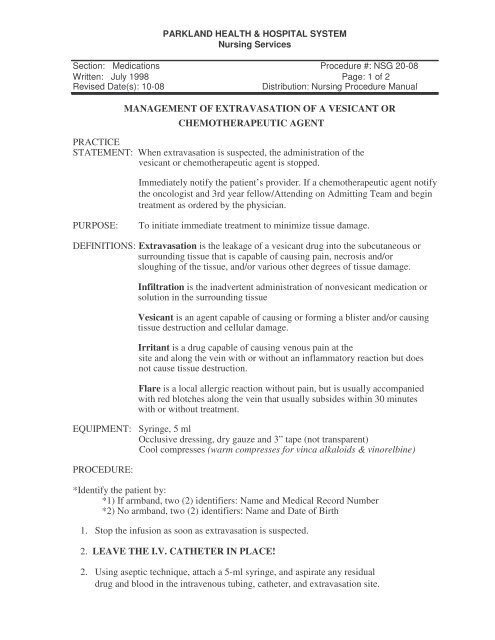



Practice Management Of Extravasation Of A Vesicant Or Parkland
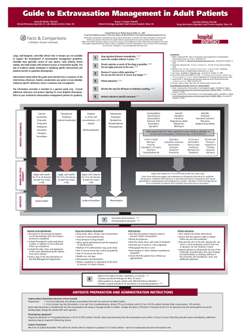



Extravasation Chart Fomo
Management of (extravasation) after it occurs, although sympathetic block and heparinization are commonly employed during acute management" This is based on results in animals with other known arteriolar irritants A case study report entitled "Extravasation of iv promethazine" can be found in Am J HealthSyst Pharm 1999; Extravasation injuries are a major cause of iatrogenic morbidity to the hospitalized patient The incidence of extravasation injury depends on both the patient and the medication, with nonvesicant extravasations occurring in 01–6% of adult patients and up to 11% of pediatric patients 1, 2 Fortunately, most of these injuries can be prevented with appropriate cannulation techniques Chemotherapy Management of Extravasation CLINICAL GUIDELINES Management of extravasation is performed by a registered nurse (RN) or healthcare prescriber with specialized training in the detection and treatment of extravasation This procedure should be instituted immediately if extravasation of a chemotherapeutic agent with vesicant properties is




Extravasation Injuries Musculoskeletal Key



Iv Infiltration Pictures
Microlearning on managing an a Vesicant or Irritant drug extravasationAssess the extravasation area for pain, blister formation, and skin sloughing periodically as needed or in accordance with institutional policy In collaboration with the physician or advanced practice nurse, refer the patient for specialized care when indicated or needed (eg, plastic or hand surgery consult, physical therapy, pain management, rehabilitation services)Conclusion There is a lack of evidencedbased information and consensus about vesicant extravasation management The antidotes sodium thiosulfate for mechlorethamine extravasations and hyaluronidase for plant alkaloid extravasations are recommended by the manufacturers of these vesicants




Extravasation



2
2Department of Pharmacy, University of ColoradoObjectives To describe the mechanisms of injury associated with DNA binding and DNA nonbinding vesicants To review various procedures used in clinical practice to manage vesicant extravasations Data sources Journal articles, published case reports, personal experience Conclusion There is a lack of evidencedbased information and consensus about vesicant extravasation managementChemotherapy Vesicant Extravasation Management 32 1 If you suspect or recognize an extravasation, please stop the chemotherapy immediately a Vesicant a medication or agent that is capable of causing tissue damage or tissue necrosis if




7 Steps For Managing Chemotherapy Extravasation



Extravasation Management
Initial Management When an extravasation occurs or is suspected, the first action is to stop the infusion or discontinue pushing the syringe containing the vesicant If the vesicant was administered via an implanted port, the noncoring needle shouldGuideline IV Extravasation Management Date of Publishing 26 September 16 219 PM Date of Printing Page 4 of 34 K\CHW P&P\ePolicy\Sept 16\Intravenous (IV) Extravasation Managementdocx This Guideline may be varied, withdrawn or replaced at any timeExtravasation Management Reference Sheet Medication Thermal Therapy Antidote Dose Treatment Amino acids (425%) Heat Hyaluronidase 150 units Give via 510 SQ or TD injections into area of extravasation Aminophylline Heat Hyaluronidase 150 units Give via 510 SQ or TD injections into area of extravasation Calcium chloride (>10%)



2



Extravasation Chart Fomo
Management of extravasation includes nursing intervention and thermal application At the first sign of extravasation, the following steps are recommended during the nursing intervention stop administration of IV fluids immediately, disconnect the IV tubing from the cannula, attempt aspiration of the residual drug from the cannular, and administer the drugspecific antidote, and Chemotherapy extravasation remains an accidental complication of chemotherapy administration and may result in serious damage to patients We review in this article the clinical aspects of chemotherapy extravasation and latest advances in definitions, classification, prevention, management and guidelinesManagement of Extravasation Injuries A Focused Evaluation of Noncytotoxic Medications Paul M Reynolds,1,2 Robert MacLaren,1 Scott W Mueller,1,2 Douglas N Fish,1 and Tyree H Kiser1,2,* 1Department of Clinical Pharmacy University of Colorado Skaggs School of Pharmacy and Pharmaceutical Sciences, Aurora, Colorado;



1




Extravasation Prevention Recognition And Management
GUIDELINE FOR MANAGEMENT OF EXTRAVASATION 1 STOP the injection immediately, but leave the cannula in place 2 Classify the agent using the tables below and treat as directed (if not listed below consult Pharmacy) 3 Collect extravasation kit 4 Apply COLD pack immediately (WARM if non DNA binding Vesicant) Vesicants DNAbinding Amsacrine 5 MANAGEMENT OF EXTRAVASATION Specific courses of action depend upon the nature of the drug how much has extravasated the location of the extravasation If an extravasation is suspected treatment must begin as soon as possible Early detection and starting treatment within 24 hours can significantly reduce tissue damage




Thomas Land Publishers Store Extravasation Management 11




Pdf Treatment Of Extravasation Injuries In Infants And Young Children A Scoping Review And Survey Semantic Scholar




National Extravasation Protocol
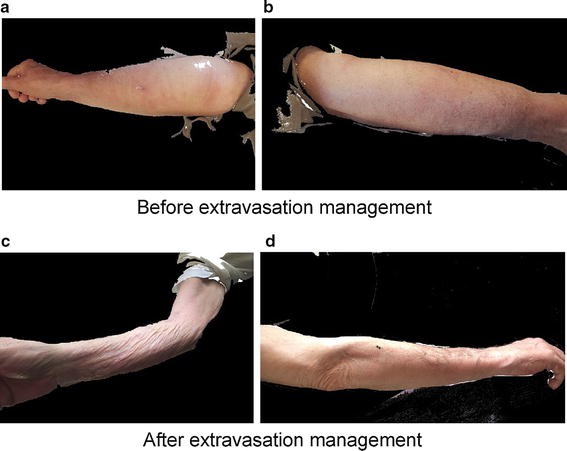



Management Of Extravasation Of Oxaliplatin By Mimicking Its Biotransformation Springerlink




Management Of The Extravasation Of Anti Neoplastic Agents Semantic Scholar




Figure 1 From Management Of Chemotherapy Extravasation Esmo Eons Clinical Practice Guidelines Semantic Scholar




Treatment Of Neonatal Extravasation Injuries Using Non Contact Low Frequency Ultrasound Development Of A New Treatment Protocol




Pdf Overview Prevention And Management Of Chemotherapy Extravasation Semantic Scholar




Management Of Vasopressor Extravasation Management Grepmed




Algorithm Showing Steps Involved In Management Of Extravasation Of Download Scientific Diagram




Pdf Vesicant Extravasation Part Ii Evidence Based Management And Continuing Controversies Semantic Scholar




Extravasation Definition Symptoms And Treatment




Scielo Brasil Opcoes De Tratamento Cirurgico Em Lesoes Cutaneas Por Extravasamento Acidental De Drogas Experiencia Do Hospital Das Clinicas Da Faculdade De Medicina Da Usp Opcoes De Tratamento Cirurgico Em




Immediate Generic Steps In The Management Of Extravasation Injuries Download Scientific Diagram
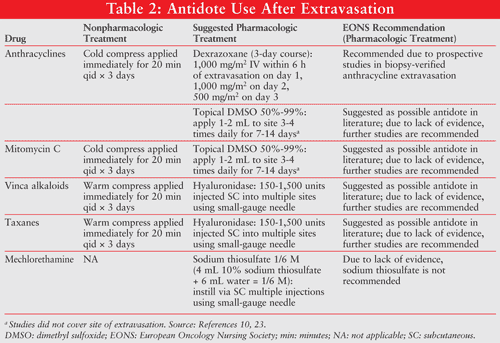



Management Of Chemotherapy Extravasations



2




Suggested Algorithm For Approaching The Management Options For Download Scientific Diagram




Pdf Vesicant Extravasation Part Ii Evidence Based Management And Continuing Controversies Semantic Scholar




Non Comparative Studies Of Conservative Management Interventions For Download Table



Extravasation Vs Infiltration Berel




Scielo Brasil Prevention And Conduct Against The Extravasation Of Antineoplastic Chemotherapy A Scoping Review Prevention And Conduct Against The Extravasation Of Antineoplastic Chemotherapy A Scoping Review



Prevention Management Of Iv Extravasation Cne Course



1




Pdf Acyclovir Extravasation Case Report And Review Of The Literature Semantic Scholar




Pdf Overview Prevention And Management Of Chemotherapy Extravasation Semantic Scholar




Immediate Management Of Chemotherapy Extravasation Grepmed




Chemotherapy Extravasation Management




Extravasation Injuries Tidsskrift For Den Norske Legeforening




Contrast Medium Extravasation Injury Guidelines For Prevention And Management Semantic Scholar



Managing Chemotherapy Extravasations In Practice Hospital Pharmacy Europe




Treatment For Extravasation Of Chemotherapy At Kyushu University Download Scientific Diagram




Management Of Chemotherapy Extravasation Esmo Eons Clinical Practice Guidelines Annals Of Oncology




Knowledge Is Power When Treating Extravasation Reactions



Extravasation Prevention Recognition And Management Document Gale Onefile Health And Medicine



2




Clinical Practice Guidelines Peripheral Extravasation Injuries Initial Management And Washout Procedure




Pdf Management Of Extravasation Injuries In Preterm Infants




Extravasation Management 1 1




Diagnosis And Management Of Urinary Extravasation After High Grade Renal Trauma Nature Reviews Urology




Oncology Nursing Society Releases Updated Guidelines On Management Of Extravasations



Extravasation Chart Fomo



2
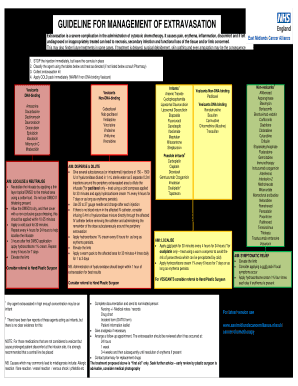



Fillable Online Extravasation Management Clinical Updaterequest Pdf Fax Email Print Pdffiller




Advanced Practice In The Management Of Extravasation



2




Extravasation Management 1 1




157 Extravasation Management Eviq



2
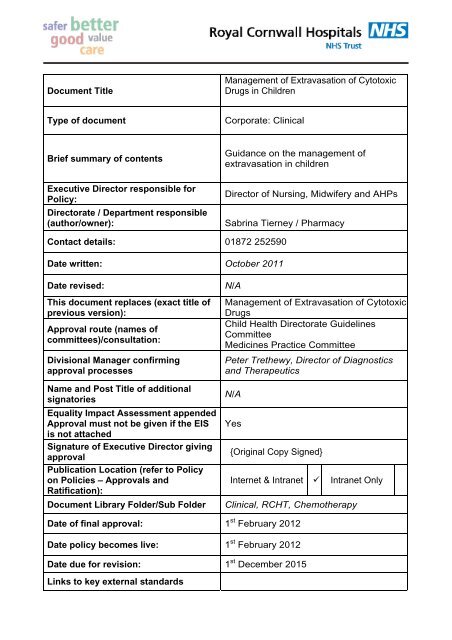



Management Of Extravasation Of Cytotoxic Drugs In Children




Pediatric Extravasation Injury Management A Survey Comparing 10 Hospitals Pediatrics Neonatology



2




Protocol For Management Of Chemotherapy Extravasations Extravasation Information




Outpatient Management Of Sodium Hypochlorite Extravasation Download Table



Lippincott Nursingcenter



Chemotherapy




Management Of Chemotherapy Extravasation Esmo Eons Clinical Practice Guidelines Annals Of Oncology




Chemotherapy Extravasation Management




Pdf Upper Extremity Extravasation Evaluation Management And Prevention



2




Consequences Of Radiopharmaceutical Extravasation And Therapeutic Interventions A Systematic Review Springerlink



2




Neonatal Extravasation An Overview And Algorithm For Evidence Based Treatment Sciencedirect




Guidelines For The Management Of Extravasation




Proposed Treatment Algorithm Individual Management Instructions I Download Scientific Diagram




Extravasation Of Cytotoxic Agents Compendium For Prevention And Management Medicine Health Science Books Amazon Com




Computed Tomography Contrast Media Extravasation Treatment Algorithm And Immediate Treatment By Squeezing With Multiple Slit Incisions Kim 17 International Wound Journal Wiley Online Library




Figure 1 Extravasation Injuries In Adults




Quick Guide Extravasation




Extravasation Management 11




Extravasation Management 1 1



Manchestercancer Files Wordpress Com



2



2




Chemotherapy Extravasations Prevention Identification Management And Documentation Semantic Scholar




Extravasation Of Chemotherapeutic Agents Ppt Video Online Download
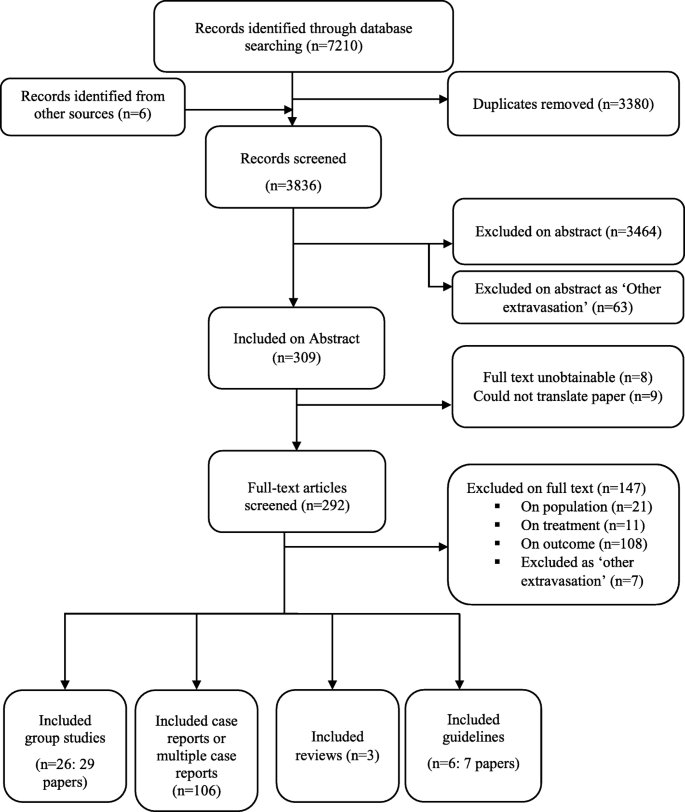



Treating Extravasation Injuries In Infants And Young Children A Scoping Review And Survey Of Uk Nhs Practice Bmc Pediatrics Full Text




Extravasation Of Contrast Media At The Puncture Site Strategies For Management Sciencedirect
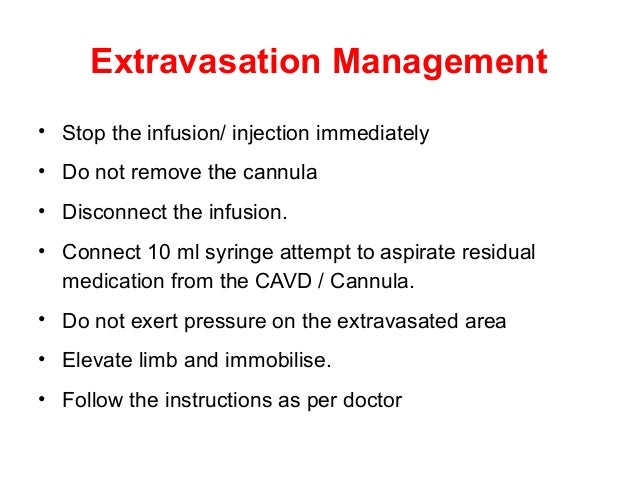



Extravasation Management 1 1




Childhood Extravasation Injuries Improved Outcome Following The Introduction Of Hospital Wide Guidelines Journal Of Plastic Reconstructive Aesthetic Surgery




Chemotherapy Extravasations Prevention Identification Management And Documentation Semantic Scholar



2




Extravasation Management Of Non Chemotherapeutic Agents Ppt Video Online Download



0 件のコメント:
コメントを投稿